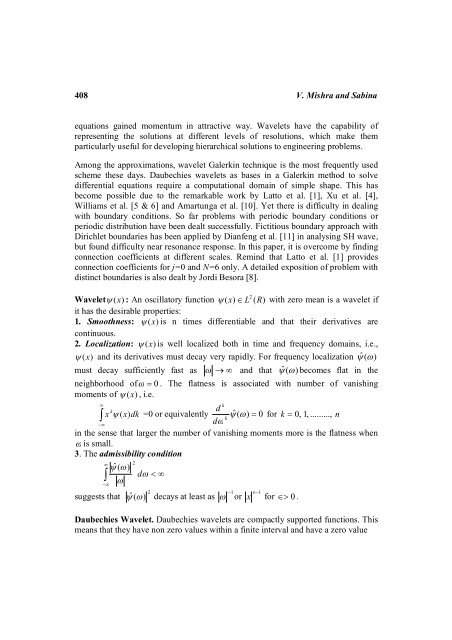Wavelet Galerkin Solutions of Ordinary Differential Equations
Wavelet Galerkin Solutions of Ordinary Differential Equations
Wavelet Galerkin Solutions of Ordinary Differential Equations
You also want an ePaper? Increase the reach of your titles
YUMPU automatically turns print PDFs into web optimized ePapers that Google loves.
408 V. Mishra and Sabina<br />
equations gained momentum in attractive way. <strong>Wavelet</strong>s have the capability <strong>of</strong><br />
representing the solutions at different levels <strong>of</strong> resolutions, which make them<br />
particularly useful for developing hierarchical solutions to engineering problems.<br />
Among the approximations, wavelet <strong>Galerkin</strong> technique is the most frequently used<br />
scheme these days. Daubechies wavelets as bases in a <strong>Galerkin</strong> method to solve<br />
differential equations require a computational domain <strong>of</strong> simple shape. This has<br />
become possible due to the remarkable work by Latto et al. [1], Xu et al. [4],<br />
Williams et al. [5 & 6] and Amartunga et al. [10]. Yet there is difficulty in dealing<br />
with boundary conditions. So far problems with periodic boundary conditions or<br />
periodic distribution have been dealt successfully. Fictitious boundary approach with<br />
Dirichlet boundaries has been applied by Dianfeng et al. [11] in analysing SH wave,<br />
but found difficulty near resonance response. In this paper, it is overcome by finding<br />
connection coefficients at different scales. Remind that Latto et al. [1] provides<br />
connection coefficients for j=0 and N=6 only. A detailed exposition <strong>of</strong> problem with<br />
distinct boundaries is also dealt by Jordi Besora [8].<br />
2<br />
<strong>Wavelet</strong> (x)<br />
: An oscillatory function ( x) L ( R)<br />
with zero mean is a wavelet if<br />
it has the desirable properties:<br />
1. Smoothness: (x)<br />
is n times differentiable and that their derivatives are<br />
continuous.<br />
2. Localization: (x)<br />
is well localized both in time and frequency domains, i.e.,<br />
(x)<br />
and its derivatives must decay very rapidly. For frequency localization ˆ<br />
( )<br />
must decay sufficiently fast as and that ˆ ( )<br />
becomes flat in the<br />
neighborhood <strong>of</strong> 0 . The flatness is associated with number <strong>of</strong> vanishing<br />
moments <strong>of</strong> (x)<br />
, i.e.<br />
<br />
x x dk<br />
<br />
k<br />
( ) =0 or equivalently ˆ<br />
( )<br />
0<br />
k<br />
k<br />
d<br />
for k 0,<br />
1,<br />
........., n<br />
d<br />
in the sense that larger the number <strong>of</strong> vanishing moments more is the flatness when<br />
is small.<br />
3. The admissibility condition<br />
<br />
<br />
<br />
ˆ<br />
( )<br />
<br />
suggests that<br />
2<br />
d<br />
<br />
2<br />
ˆ( )<br />
decays at least as<br />
1<br />
or<br />
1<br />
x for 0 .<br />
Daubechies <strong>Wavelet</strong>. Daubechies wavelets are compactly supported functions. This<br />
means that they have non zero values within a finite interval and have a zero value
















